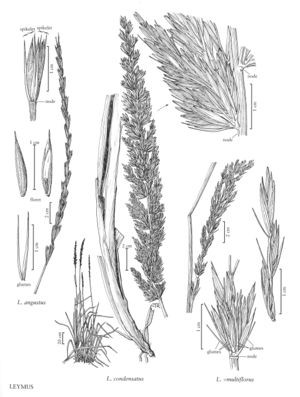Leymus condensatus
Plants cespitose, weakly rhizomatous. Culms 115-350 cm tall, 6-10 mm thick, usually several to many together. Leaves exceeded by the inflorescences; auricles absent; ligules 0.7-6 mm on the basal leaves, 4-7.5 mm on the flag leaves; blades 10-28 mm wide, abaxial surfaces glabrous, smooth, adaxial surfaces scabridulous, veins numerous, subequal or unequal. Inflorescences panicles, 17-44 cm long, 20-60 mm wide, lower nodes with 2-6 branches, branches to 8 cm, ascending, with 5-35 spikelets, upper nodes with pedicellate and sessile spikelets; internodes 3.5-10 mm, glabrous. Spikelets 9-25 mm, usually pedicellate, pedicels 0.8-2 mm, with 3-7 florets. Glumes 6-16 mm long, 0.5-2.5 mm wide, narrowly lanceolate, stiff, keeled, the central portion thicker than the margins, glabrous, smooth proximally, scabrous distally, 0-1 (3) -veined, veins inconspicuous at midlength, apices tapering almost imperceptibly into an awn, awns subequal to the glume body; lemmas 7-14 mm, usually glabrous, apices acute, sometimes awned, awns to 4 mm; anthers 3.5-7 mm, dehiscent. 2n = 28, 56.
Distribution
Alta., B.C., Calif.
Discussion
Leymus condensatus is found primarily on dry slopes and in open woodlands of the coastal mountains and offshore islands of California, at elevations of 0-1500 m. Both its large size and paniculate inflorescence tend to make it a distinctive species in the Triticeae. Hybrids between L. condensatus and L. triticoides, known as Leymus xmultiflorus, are relatively common where the parents are sympatric.
Selected References
None.
Lower Taxa
"decumbent" is not a number."/2-33/4timesthelengthof" is not declared as a valid unit of measurement for this property.
